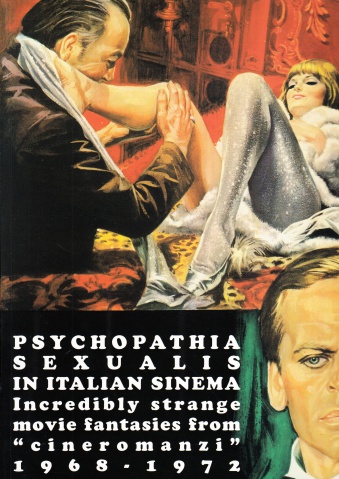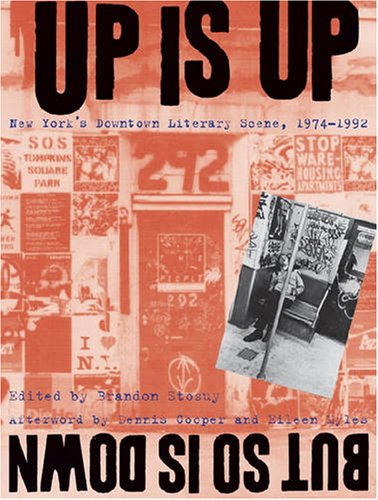Stefano Piselli, Riccardo Morrocchi (eds.): Psychopathia Sexualis in Italian Sinema, 1968-1972 (2004) [English/Italian]
Filed under book | Tags: · 1960s, 1970s, body, cinema, eroticism, film, film history, nudity, sexuality

Franco the libertine, Ella the nymphomaniac, Gilberto the mad sadist, Sayer the aesthete sadist, Mary the homicidal mantis, Ahmed the debauched, X. the vicious politician, X. the fanatic and moralist judge, Kay the sexually dissatisfied, the mysterious Greta, Diana the arrogant mistress and her black servant Janita, Santino the foot fetichist, the psychopatic Dr. Lyutak, the submissive Marcia, the refined Lesbians Paula and Mudy, Silvia the happy masochist… These are the eccentric characters enliving the stories of this anthology of Italian movies from the so-called Sexual Revolution, featured in the form of “cineromanzo”. Krafft-Ebing’s theories, Sade’s fantasies, Freud’s analyses in a mix of sequences chosen from rare Italian magazines of the 1970s.
Publisher Glittering Images, Firenze, 2004
ISBN 8882750477
104 pages
PDF (21 MB)
See also Bizarre Sinema! Jess Franco. El sexo del horror, 1999. (in English/Italian, 30 MB, no OCR)
Sally Banes: Terpsichore in Sneakers: Post-Modern Dance (1980/87)
Filed under book | Tags: · 1960s, 1970s, body, choreography, dance, theatre

“Sally Banes writes criticism with a dancer’s feel for dancing, a personal acquaintance with the choreographers she writes about, a solid knowledge of critical theory, and an awareness of the many relationships of post-modernism to the contemporary cultural context. Terpsichore in Sneakers is a first-rate contribution to our post-modern dance.
Banes restricts her discussion to ten choreographers: six members of Robert Dunn’s 1960-62 composition workshop (Yvonne Rainer, Steve Paxton, Trisha Brown, David Gordon, Deborah Hay, Simone Forti), all but the last of whom were early members of the Judson Dance Theater, three second-generation Judson choreographers (Meredith Monk, Kenneth King, Lucinda Childs), and Doug Dunn, who performed with Rainer, Paxton, Brown, and Gordon in the Grand Union.” (from the review by Milton H. Snoeyenbos, The Journal of Aesthetics and Art Criticism, 1980)
Originally published by Houghton Mifflin, Boston, 1980
Publisher Wesleyan University Press, 1987
With a new Introduction
ISBN 0819561606
311 pages
Commentary (André Lepecki, Dance Theatre Journal, 1999)
EPUB
See also films and videos in UbuWeb’s dance section
Brandon Stosuy (ed.): Up Is Up, But So Is Down: New York’s Downtown Literary Scene, 1974-1992 (2006)
Filed under book | Tags: · 1970s, 1980s, 1990s, art, diy, history of literature, literature, music, new york, poetry, publishing, theatre

“Sometime after Andy Warhol’s heyday but before Soho became a tourist trap, a group of poets, punk rockers, guerilla journalists, graffiti artists, writers, and activists transformed lower Manhattan into an artistic scene so diverse it became known simply as “Downtown.“ Willfully unpolished and subversively intelligent, figures such as Spalding Gray, Kathy Acker, Richard Hell, David Wojnarowicz, Lynne Tillman, Miguel Piñero, and Eric Bogosian broke free from mainstream publishing to produce a flood of fiction, poetry, experimental theater, art, and music that breathed the life of the street.
The first book to capture the spontaneity of the Downtown literary scene, Up Is Up, But So Is Down collects more than 125 images and over 80 texts that encompass the most vital work produced between 1974 and 1992. Reflecting the unconventional genres that marked this period, the book includes flyers, zines, newsprint weeklies, book covers, and photographs of people and the city, many of them here made available to readers outside the scene for the first time. The book’s striking and quirky design—complete with 2-color interior—brings each of these unique documents and images to life.
Brandon Stosuy arranges this hugely varied material chronologically to illustrate the dynamic views at play. He takes us from poetry readings in Alphabet City to happenings at Darinka, a Lower East Side apartment and performance space, to the St. Mark’s Bookshop, unofficial crossroads of the counterculture, where home-printed copies of the latest zines were sold in Ziploc bags. Often attacking the bourgeois irony epitomized by the New Yorker’s short fiction, Downtown writers played ebulliently with form and content, sex and language, producing work that depicted the underbelly of real life.
With an afterword by Downtown icons Dennis Cooper and Eileen Myles, Up Is Up, But So Is Down gathers almost twenty years of New York City’s smartest and most explosive—as well as hard to find—writing, providing an indispensable archive of one of the most exciting artistic scenes in U.S. history.”
With an afterword by Dennis Cooper and Eileen Myles
Publisher NYU Press, 2006
ISBN 9780814740118
500 pages
Downtown Collection at NYU’s Fales Library
Reviews: Ed Halter (Village Voice, 2006), Meghan O’Rourke (New York Times, 2006), Tim W. Brown (Columbia Journal of American Studies, n.d).
Commentary: Cynthia Carr (New York Times, 2006), Peter Cherches (2006).
PDF (39 MB, updated on 2019-8-23)
Comments (2)
